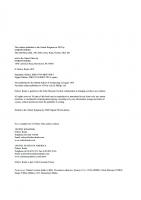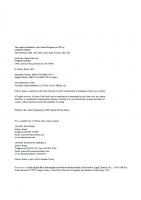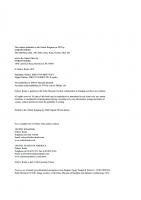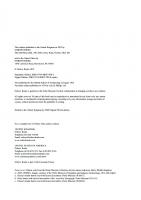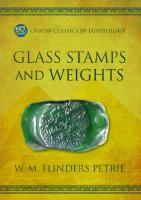Objects of Daily Use (Oxbow Classics in Egyptology) 9798888570128, 9798888570135
206 99 67MB
English Pages [146]
Cover
Book Title
Copyright
CONTENTS
LIST OF PLATES
PREFACE TO THE 2023 EDITION
PUBLISHER’S PREFACE
INTRODUCTION
1. Scope of the volume
2. Dating of objects
3. Collateral material
CHAPTER I NECK AND HEAD ORNAMENTS
4. The earlier groups
5. Necklaces 600–300 B.C
6. Ptolemaic necklaces
7. Roman necklaces
8. Necklets
9. Neckrings of northern origin
10. Bullae, coins, &c
11. Head ornaments
12. Various ornaments
CHAPTER II BRACELETS AND GOLD RINGS
13. Egyptian bracelets
14. Roman bracelets
15. Late Roman or Coptic bracelets
16. Pendants
17. Egyptian gold finger rings
18. Roman gold finger rings
CHAPTER III EARRINGS
19. Egyptian earrings
20. Boat shaped earrings
21. Group from Memphis
22. Late Egyptian types
23. Greek earrings
24. Roman earrings
25. Late Roman earrings
CHAPTER IV EARLY STONES AND EGYPTIAN RINGS
26. Early numbered stones
27. Foreign cylinders
28. Syrian seals
29. Roman figure and key rings
30. Egyptian glazed and glass rings
31. New Year rings and scarabs
32. Egyptian subjects
33. Graeco-Egyptian rings
34. Classical rings
35. Late Egyptian rings
36. Byzantine rings
37. Arab rings and stones
CHAPTER V ENGRAVED STONES
38. Semitic stones
39. Egyptian and uncertain stones
40. Archaic Greek gems
41. Graeco-Roman gems
42. Clay impressions of gems
43. Large rings and stones
44. Gnostic stones and pastes
CHAPTER VI HAIR RINGS, EAR STUDS, BUCKLES, HAIR PINS, COMBS
45. The use of the rings
46. Cut rings
47. Bent glass rings
48. Divided studs for the ear
49. Ear discs
50. Mushroom studs
51. Gold pendants and rings
52. Belt fastenings
53. Fibulae
54. Inlaid buckle plates
55. Bells
56. Hair pins of xiith and xviiith dynasties
57. Roman hair pins
58. The development of combs
59. Combs of xiith and xviiith dynasties
60. Roman combs
CHAPTER VII KOHL TUBES AND STICKS
61. The use of eye paint
62. Stone tubes
63. Wooden tubes
64. Reed tubes
65. Kohl-sticks, unguent spoons
CHAPTER VIII MIRRORS
66. Forms of mirrors
67. Objects associated with mirrors
68. Handles of mirrors
69. List of mirrors
70. Roman glass mirrors
CHAPTER IX HEAD RESTS
71. Use of the head rest
72. Head rests of iind, iiird dynasties
73. Head rests of ivth–vith dynasties
74. Head rests of ixth–xith dynasties
75. Head rests of xviiith, xixth dynasties
76. Graeco-Roman head rests
CHAPTER X BOXES, SPOONS, AND TOILET TRAYS
77. Boxes and lids
78. Spoons
79. Horn
80. Egyptian trays
81. Roman trays, inside
82. Outsides of trays
83. Purpose of trays
CHAPTER XI IVORY AND BONE CARVING
84. Early figures
85. Magic wands
86. Classification and dates
87. Subjects represented
88. Purpose
89. Meaning
90. Catalogue of wands
91. Hand wands for dancing
92. Ivory figures
93. Floral forms
94. Artificial forms
95. Roman ivory carving
96. Wood carving
CHAPTER XII FURNITURE AND WOODWORK
97. Furniture
98. Boxes and bowls
99. Woodwork
100. Basketry
CHAPTER XIII METAL FITTINGS
101. Lead
102. Bronze
103. Furniture fittings
CHAPTER XIV GAMES
104. Classes of games
105. Sent game
106. Playing pieces
107. Square board games
108. Spiral game of henn
109. Siga
110. Graeco-Roman game pieces
111. Music
112. Wands for dancing
CHAPTER XV TOYS
113. Tip cat and tops
114. Balls
115. Rattles
116. Figures of limestone
117. Dolls
118. Mud toys
119. Roman toys, groups
CHAPTER XVI WRITING
120. The scribe’s outfit
121. Catalogue of palettes
122. Pen cases
123. Roman case and pens
124. Writing tablets
125. Examples of writing
126. Writing on vases
127. On wood and metal
CHAPTER XVII STAMPS
128. Hieroglyphic
129. Roman age
130. Arabic
131. Clay sealings
132. Slips of stick
133. Examples of painting
Index
Plate
Back Cover
Recommend Papers

- Author / Uploaded
- Sir W.M. Flinders Petrie
File loading please wait...
Citation preview
Oxford & Philadelphia
This edition published in the United Kingdom in 2023 by OXBOW BOOKS The Old Music Hall, 106–108 Cowley Road, Oxford, OX4 1JE and in the United States by OXBOW BOOKS 1950 Lawrence Road, Havertown, PA 19083 © Oxbow Books 2023 Paperback Edition: ISBN 979-8-88857-012-8 Digital Edition: ISBN 979-8-88857-013-5 (epub) First published by the British School of Archaeology in Egypt, 1927 Facsimile edition published in 1974 by Aris & Phillips Ltd Oxbow Books is grateful to the Petrie Museum for their collaboration in bringing out these new editions All rights reserved. No part of this book may be reproduced or transmitted in any form or by any means, electronic or mechanical including photocopying, recording or by any information storage and retrieval system, without permission from the publisher in writing.
Printed in the United Kingdom by CMP Digital Print Solutions
For a complete list of Oxbow titles, please contact: United Kingdom Oxbow Books Telephone (0)1226 734350 Email: [email protected] www.oxbowbooks.com United States of America Oxbow Books Telephone (610) 853-9131, Fax (610) 853-9146 Email: [email protected] www.casemateacademic.com/oxbow Oxbow Books is part of the Casemate Group
Front cover: Wooden comb carved in the form of a seated cat. Provenance unknown, likely Dynasty 18 (c. 1550–1069 BC). Petrie Museum UC40667. Image courtesy of the Petrie Museum of Egyptian and Sudanese Archaeology, UCL.
vi
PREFACE TO THE 2023 EDITION In the 1970s, a much-anticipated new series of publications illustrated objects and themes related to the excavations of the archaeologist William Matthew Flinders Petrie (1853–1942) in Egypt, and aspects of the collection of University College London’s Petrie Museum of Egyptian and Sudanese Archaeology. A young couple setting up in business in the early 1970s, Aris and Phillips published these works, written by members of the UCL Egyptology Department, in their Modern Egyptology series. Building on Petrie’s own observations, the authors of these volumes aimed to complete the great task of publishing the Petrie Museum of Egyptian and Sudanese Archaeology’s vast collection, and to present some of the research that Petrie himself was not able to address in his own published works during his lifetime. As the current Curator of the Petrie Museum, it is a great privilege for me to support Oxbow Books in their mission to republish the series, which remains a key source of information for all those interested in object-based approaches to the study of the ancient world. The Petrie Museum, part of University College London (UCL), is home to one of the largest and most significant collections of Egyptian and Sudanese archaeology in the world. Free to visit, this extraordinary collection tells stories about the lives of ordinary people who lived along the Nile Valley thousands of years ago. Originally set up as a teaching collection, the Petrie Museum comprises over 80,000 objects housed together with an internationally important archaeological archive. It is a collection of world firsts and ‘oldests’: the oldest woven garment; the oldest worked iron objects; the first known depiction of loom weaving; the oldest known written document about women’s health; the earliest veterinary treatise; the oldest will on paper. The Museum has Designated Status from Arts Council England, meaning that it is considered to have outstanding resonance and national cultural significance. The collection has a substantial, visible international reputation for research, supporting hundreds of researchers every year, both remotely and in person. The Petrie Museum is named after Flinders Petrie, who was appointed in 1892 as the first Professor of Egyptian Archaeology and Philology in the UK at UCL. Over three-quarters of the material in the Museum comes from excavations directed or funded by Petrie, or from purchases he made for university teaching. In 1880 at
the age of 26, Petrie travelled to Egypt to survey the Great Pyramid. For the next five decades he was at the forefront of the development of archaeology in Egypt and later in Palestine, and his detailed methodological approach continues to shape the discipline today. Petrie worked at more sites, with greater speed, than any modern archaeologist: seeing his life as a mission of rescue archaeology, Petrie aimed to retrieve as much information as possible from sites that were shrinking dramatically in size as Egypt modernised during the late 19th and early 20th centuries. He published a large part, but not all, of the finds from his excavations in his illustrated typological volumes, arranged according to object types and themes. Today, much of the Petrie Museum’s collection is displayed and stored in a way which reflects these publications: for example, several storage cupboards are dedicated to the material illustrated in the ‘Objects of Daily Use’ volume, and objects in the drawers are arranged according to the order of the published plates. This offers a unique opportunity for researchers to engage with Petrie’s typological and methodical approach to archaeology, as well as with the history of museum collections. The first catalogue to be published in the Modern Egyptology series was Amarna: City of Akhenaten and Nefertiti in 1972 by Julia Samson, Petrie Museum Honorary Research Assistant. As official publishers to the UCL Egyptology Department the series went on to produce facsimile reprints of eight of Flinders Petrie’s most important site reports and many of his object catalogues, originally published through the British School of Archaeology in Egypt. The substantial annual royalties from these reprints were paid into the ‘Petrie Fund’ at the time, which provided special grants to students in financial need. In many ways, the new reprints of this classic series can be seen as the latest layer in a vast ‘publication stratigraphy’ of the thousands of finds from Flinders Petrie’s excavations, which now live in museum collections around the world. On reading these volumes, I hope that readers will also be inspired to learn more about the Petrie Museum collection and its fascinating history. Dr Anna Garnett Petrie Museum of Egyptian and Sudanese Archaeology, University College London January 2023 vii
PUBLISHER’S PREFACE Oxbow Books is pleased to present this title in our Classics in Egyptology series. This series of facsimile re-issues is comprised of two sub-series. The first consists of 16 typological catalogues produced by W.M. Flinders Petrie based on his massive collection of Egyptian artefacts. Mostly excavated by Petrie during many seasons of campaign in the last years of the 19th and early decades of the 20th century, they now reside in the Petrie Museum at University College London. Published between 1898 and 1937 and long out of print, the catalogues were re-issued in facsimile by publishers Aris and Phillips in the 1970s. These were followed in the next 15 years or so by publication of a number of newly commissioned titles, based on more recent examination of elements of the Petrie Collection by contemporary experts, under the name Modern Egyptology. A selection of these additional titles forms the second component of our own series. The archaeology of Egypt continues to fascinate. Multi-disciplinary investigation and research continues unabated, encompassing methodologies, scientific and data processing techniques, theoretical approaches, and even whole paradigms that were unheard of in the 1970s and undreamt of when Petrie was working in Egypt. Yet all the titles included in this series continue to be invaluable sources of basic data, providing an unparalleled resource that can easily be cross- referenced with the actual materials they describe and discuss. They remain within the Petrie Collection where they may be accessed and re-examined as new research flourishes. As historic documents, the Petrie
viii
catalogues stand as exemplars of the craft of typological classification, the backbone of modern archaeology – much of which, though refined by absolute dating and another 100 years of research, still stands the test of time.
A note on presentation The facsimile titles of Petrie’s catalogues re-issued in the 1970s were produced from scans of the original publications. Scanning technology at that time was not of the standard or resolution of today. The scans are no longer available, nor has it been possible to obtain, and in doing so destroy, original copies of the Petrie catalogues. These titles have therefore, of necessity, been rescanned from the 1970s re-issues. Where necessary the pages have been digitally enhanced for clarity of reading and to ensure the good quality of the plates, though inevitably a few are not of the standard we might wish, because of the quality of the previous scan, and occasional blocks of text are not precisely ‘straight’ or evenly situated on the page. However, some pages in the 1970s re-issues had been inserted in the wrong order and this has been corrected. The originals were produced at a folio size. The pages have been reduced slightly to standard A4 for ease of shelving and because this has the effect of slightly improving the scanned images. In some cases, illustrations were presented to scale and the original scale is given on the plate. There were also no digital files available for titles included in the Modern Egyptology series, so these too have been scanned from printed copies.
I
II
IV
VI
VIII
X
XI
XIV
V
XXXIX
XLIV
XLIX
LII
LV
LVI
